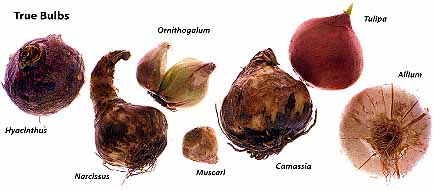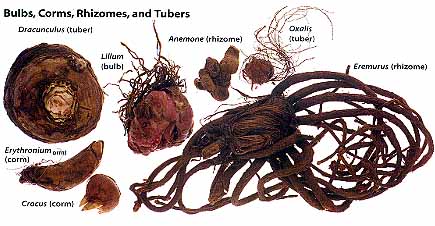What is a bulb?
A flower bulb is really an underground storehouse and flower factory. Within the bulb is just about everything the plant will need to sprout and flower at the appropriate time. Split a bulb in half and you will see this clearly.
In the basal center portion of the bulb are the leaves cradling a baby bud. (In many species, this bud already has the appearance of a flower while still in the bulb!) Surrounding the bud is a white, meaty substance called the scales. In true bulbs, it is these scales which contain all the food the bulb will need to flower and thrive. Anchoring the scales and the floral stalk which holds the bud is the basal plate. This plate at the bottom of the bulb also holds the roots of the plant. The entire package is protected by a thin outer skin called the tunic.
All this remarkable organism needs from humans is to be placed in the ground at the appropriate season of the year, given a liberal drink of water and then left alone. The bulb does the rest!

The Difference Between Bulbs, Corms, Tubers, Roots
Technically speaking, many popular "bulb" flowers are not produced from true bulbs at all. Crocuses and gladioli, for example, are really corms, while such favorites as dahlias and begonias are really tubers.
The differences between bulbs and corms are slight, and indeed the two look very similar. The main distinguishing trait is the method of storing food. In corms, most of the food is stored in an enlarged basal plate rather than the meaty scales, which in corms are much smaller. Corms generally tend to be flatter in shape than round, true bulbs.

Tubers and roots are easily distinguished from bulbs and corms. They have no protective tunic and are really just enlarged stem tissue. They come in a variety of shapes, from cylindrical, to flat, to just about any combination you can imagine. Many come in clusters.
Generally, however, you are safe using the term "bulb." Bulb has commonly come to mean any plant which has an underground food storage capacity.
|
